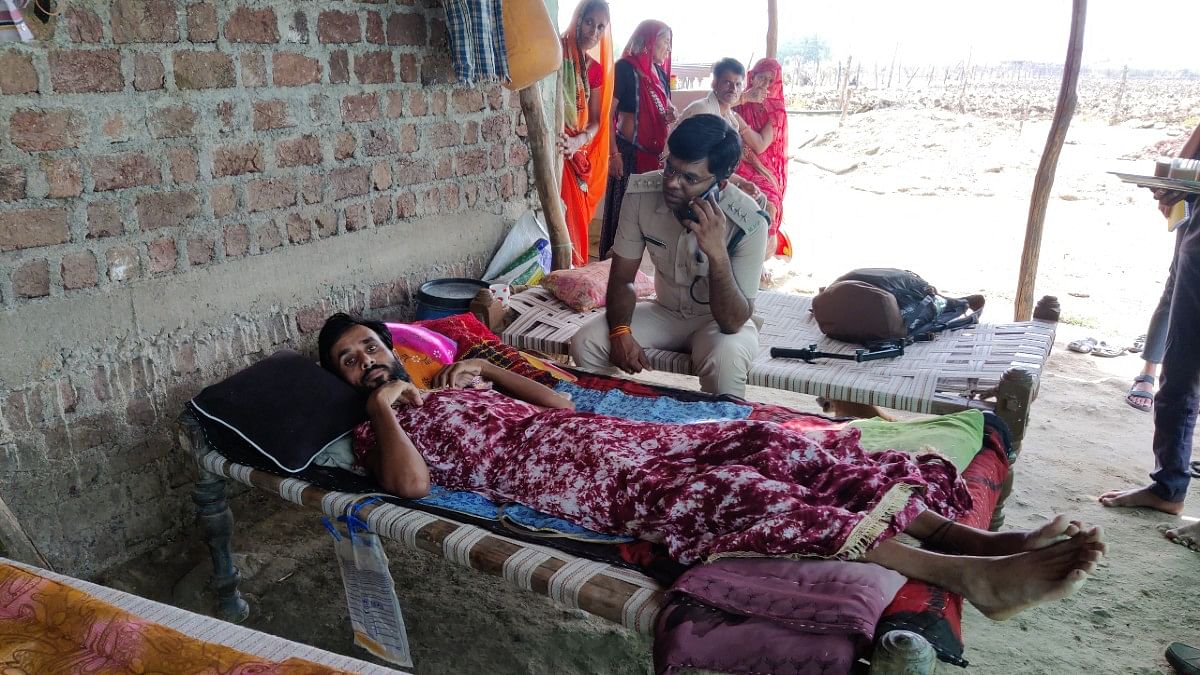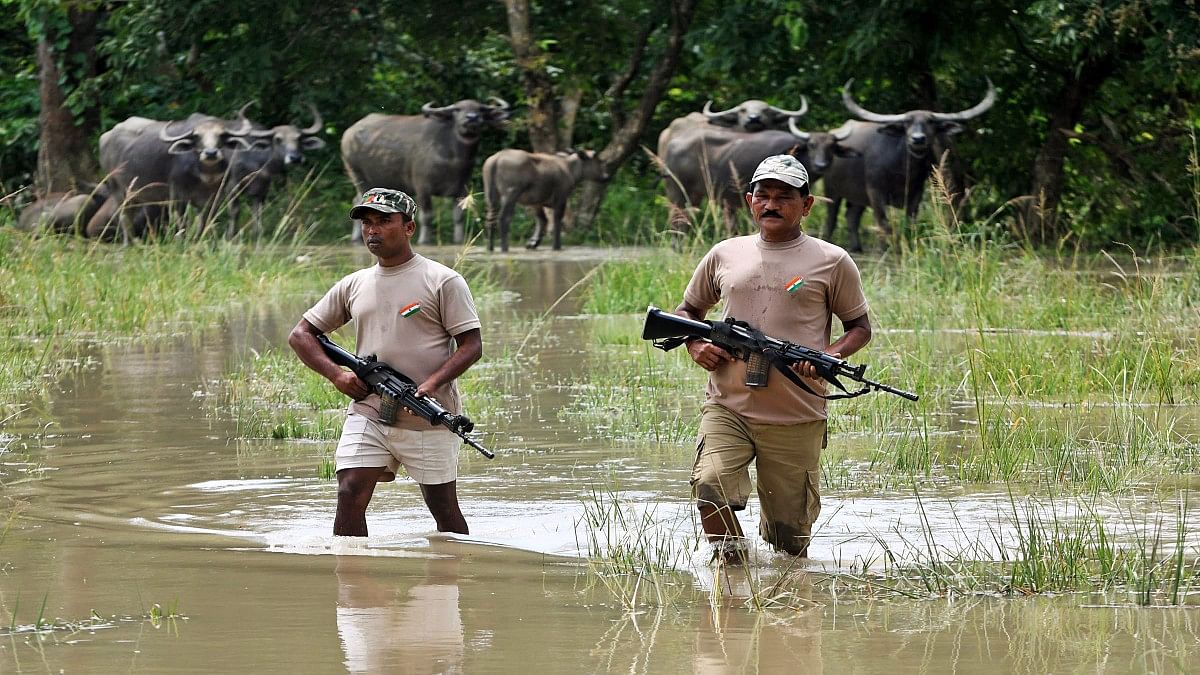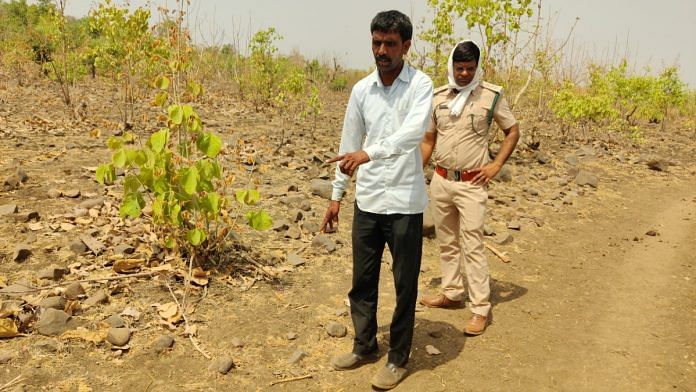Guna/Bhopal: After 17 days in hospital, Parvat Gujjar is back home in Madhya Pradesh’s Bhamora village, still bed-ridden. A colostomy bag hangs from his side, and a thin blanket covers his body despite the sweltering heat.
It will be weeks before he can walk, and months before he can return to his job, guarding the forests of Bhopal.
Parvat is a ‘chowkidar’, the lowest rung of workers tasked with patrolling forests in the region. On the night of 30 April, Parvat, along with fellow chowkidar Inder Gujjar, went to investigate “flashing lights”.
“It was after my duty had finished. I came out to get a sip of water, and that’s when I saw the lights,” he said.
The forest was shrouded in darkness, except for the flashes of light in the distance, said Parvat. The source was a group of suspected poachers on the prowl. “We crept up to the spot, but they saw us and we got into a fight. Eventually, they opened fire.”
The poachers shot Parvat in the groin, and stabbed Inder in the hip before fleeing the spot, leaving behind a bloody knife.

It was 25-year-old Parvat’s first encounter with poachers, but Inder has had several run-ins with them over his 11-year stint as a chowkidar. “Sometimes, we catch them, other times we don’t,” Inder said, shrugging.
Such conflicts are common, but, more often than not, the outcome is tilted in favour of the poachers. Not just daily-wage chowkidars like Inder and Parvat, but forest officers, too, cannot use guns to retaliate or defend themselves without risking arrest.
In May this year, the Madhya Pradesh forest department appealed to the state government to grant forest personnel arms and the legal protection to use them in self-defence — powers granted to forest rangers only in Assam and Maharashtra. The demand was made after three policemen were killed, reportedly by poachers, in Guna district.
The hesitancy in granting the forest department arms stems from the volatile relationship the department shares with local communities. Experts point out that while self-defence is a valid argument for arming them, for forest guards to feel empowered, there is an urgent need to improve their working conditions.
The Madhya Pradesh forest department has distributed 3,443 guns (including revolvers) to forest staff in all 50 districts, “but they are encouraged to use sticks”, said MP’s additional principal conservator of forests (protection) Ajit K. Srivastava.
Also Read: This Tamil Nadu IFS officer saves environment by day, and draws what she protects by night
Sticks versus guns
It is unlikely that firearms will replace the danda (stick), which has become a symbol of the forest department, serving as the only form of defence for those protecting most of India’s jungles.
According to the International Federation of Rangers, India was considered the most dangerous country for forest rangers in 2017, accounting for the largest proportion of casualties worldwide.
State officials say that, since 1961, as many as 52 forest staffers in Madhya Pradesh have been killed on duty.
The majority, 28, died at the hands of illegal miners and commercial timber traders, the officials add. Two were killed by alleged poachers, and six by wildlife. The toll does not include chowkidars who are not considered forest staff.
Madhya Pradesh does allow some of its forest guards to be armed, but they are not protected by sub-section two of Section 197 in the Code of Criminal Procedure (CrPC). Forest personnel are, by default, excluded from this provision, which protects police and armed forces from criminal proceedings if they commit an “offence in the discharge of official duty”.
Under current circumstances, if a forest guard or officer fires a bullet to kill, he or she is liable to be charged and arrested for an offence under the Indian Penal Code. So far, all forest staff charged with this kind of crime have been released, state department officials claimed.
But forest officers themselves are wary of being penalised for using a firearm. “I’m allowed to carry a pistol, but I don’t carry it with me. What if I fire in self-defence and I’m slapped with a case? It’s not worth it,” said a range officer in Guna district who survived a poaching attack two years ago.
At most, forest guards can shoot below the waist after shooting in the air as a warning.
Ritesh Sirothia, an Indian Forest Service (IFoS) officer who leads the state’s Tiger Strike Force, is of the view that arming forest guards is a “win-win” situation, if MP follows the same provisions as Assam and Maharashtra.

“Why are police going into the forests? It’s because forest personnel don’t have the authority to use guns to even defend themselves. But we know the forests better, we know its people better. If we are given protection from immediate arrest after firing a gun, we will be able to do our jobs without fearing action,” he said.
Of the 500 to 700 poaching cases that Madhya Pradesh records in a year, the majority are for smuggling of bushmeat or for black magic. Only a fraction are related to commercial trade. The last international tiger poaching racket in MP was busted in 2015, although other endangered species, such as the red–crowned roof turtle, continue to be smuggled out of the state.
Sirothia, who won the international Clark R. Bavin Wildlife Enforcement Award in 2016 for his work busting international poaching syndicates, wants the wildlife wing to be granted powers to intercept calls to better monitor international poaching and trade.
It is an ambitious demand, given how closely it mirrors the powers of law enforcement agencies. “The central government would need to amend the IT Act so these powers can be given to us,” he said.
To arm or not to arm?
Some experts argue that arming forest staff could further “skew the power imbalance” between forest-dwelling communities and the department in favour of the latter.
“There is a lot of antagonism between local communities and the forest department in many places. Forest personnel definitely need better equipment, and in a way guns could be useful against repeat offenders involved in organised crime, and help in self-defence,” said Anish Andheria, CEO of Wildlife Conservation Trust, which trains and equips forest personnel across 23 states.
“But it isn’t the solution against casual offenders or villagers who are dependent on forest resources due to abject poverty. Guns will probably cause further divide between the department and communities, who are doubly marginalised,” he added.
Prakash Kashwan, associate professor of political science at the University of Connecticut, argues in his book, Democracy in the Woods, that the forest department has “disproportionate powers” over adivasi and forest-dwelling communities.
The department functions under the colonial-era Indian Forestry Act of 1927, which is a law designed to give the British power over “colonised Indians who may have rightly resisted the exploitation of forests by a colonial force”.
Kashwan told ThePrint over email that while forest guards “need strong support”, guns are not the solution.
“The quest for the welfare of local forest officials should start with an overall improvement in their working conditions. How can a lone forest official, even when equipped with a gun, confront professional poachers who will always have better guns?” he said.
In parts of Assam and Maharashtra, if a forest guard shoots and kills a person, a magisterial inquiry is set up to ascertain whether ‘excess force’ was used, and arrest is made on the basis of the inquiry’s findings.
However, tribal populations around Kaziranga in Assam, where rhino poaching is rampant, allege that, in several cases, due process was not followed and no such inquiry was set up.
According to a BBC report, one forest guard had been killed by poachers in 20 years, while 106 people had been killed by guards in the same period.
More boots on ground
Madhya Pradesh has the largest area-wise forest cover in the country at 77,493 square kilometres, followed by Arunachal Pradesh, Chhattisgarh, Odisha and Maharashtra.
Patrolling forms the backbone of forest governance, but often involves working under strenuous circumstances. Forest guards and chowkidars in MP often work alone, patrolling an average terrain of 700 to 2,000 hectares.
In the peak of summer, they risk their lives to put out fires. At other times, they are caught unawares and mauled by predators like leopards or tigers.
“The constraint is in patrolling. If one forest guard is handling 12 square kilometres of forest plus surrounding agricultural land, how will he do it? That too without a gun,” said Srivastava, the additional principal conservator of forests (protection).
Both forest officials and experts agree that there is a need to invest in personnel and improve their work conditions. Surveys by the Wildlife Conservation Trust (WCT) found that, on average, forest guards have to travel over 30 km for basic medical care, with 29 per cent contracting malaria while on the field.
“In the police, you have different departments for different kinds of crimes — the ED, CBI, NIA. But forest staff look after everything from creating plantations and cracking down on illegal felling and mining to controlling fires and preventing poaching activities. Each of these areas needs specialised focus and knowledge” said Sirothia.
Amodh Tiwari, general secretary of the Madhya Pradesh forest workers’ union, told ThePrint that apart from arms and legal protection to use them in self-defence, the department needs more boots on the ground, better equipment, and better medical facilities.
“We need motorcycles so our guards can travel longer distances during patrol. We need better veterinarian doctors in every district, those who know how to treat wildlife and not just cattle. The forest department needs to be strengthened from the bottom up,” he said.
According to Kashwan, the forest department “suffers the consequences of an inverted pyramid”.
“There are a large number of officers in higher ranks that consume a very significant portion of the forest department budget, without investing enough in creating an enabling environment for the lower-ranking officials,” he said.
Even though it is better placed than most other states, MP’s forest department suffers from vacancies across key positions. Of the 14,024 forest beat guard positions in the state, 1,913 are lying vacant, according to state department data. Of the 5,388 posts reserved for foresters and forest rangers (who perform similar duties as forest guards), 2,148 are unoccupied.
Chowkidars like Inder and Parvat, meanwhile, are daily-wage workers hired in large numbers to make up for the shortfall, and are paid approximately Rs 338 a day to assist forest guards.
Low morale
In 2013, Prerna Singh Bindra, a wildlife conservationist and then a member of the National Board for Wildlife, submitted an agenda to the Ministry of Environment, Forest and Climate Change, asking that states create a “well-defined policy for the appropriate management and welfare of the uniformed forest staff”.
The agenda covered rationalising working hours, creating a hardship allowance, and providing staff with life insurance, among other issues.
“A committee was formed to push the agenda forward, and there were two sittings, but after that it appears to have fizzled out and nothing concrete has come out of it,” she told ThePrint.
Devendra Soniya, a forest guard in the Berasia range, said that despite living in a range close to the city, he doesn’t get water or electricity for most of the day. His reporting range officer, N.K. Chouhan, said the department receives equipment such as torches and chest guards once in two years.
“Unlike a police thana (station), forest guards live alone. In my headquarters, I get electricity for five hours a day. There’s no stable supply of water either. In more remote areas, it’s even worse,” said Devendra.
Working in such conditions has affected morale. Another WCT survey in 2019, on the motivation levels of forest staff in Madhya Pradesh found that they were in dire need of “a sense of achievement”, and recommended more recognition for their work, higher pay, and better equipment.
The policemen killed in Guna were declared “martyrs” by the state, and their families given a compensation of Rs 1 crore each. But for forest staff, whose deaths rarely make national headlines, compensation is limited to Rs 10 lakh, said Srivastava.
Repairing a fragile relationship
Forest-dwelling communities and the authorities have an uneasy relationship where the tussle for forest land also comes into play.
Madhya Pradesh is among the states to have received the highest number of claims (6,09,501 to be precise) under the Forest Rights Act — a law that recognises the historical rights of tribal and other traditional forest-dwelling communities to forest resources. However, 61 per cent of these had been rejected, as of 2016.
In Guna district, forest range officers narrated some of their experiences while out on patrol.
“We had learned that some villagers were destroying plantations in the Aaron forest, and so we went there to check it out. They claimed the land was theirs and accused us of harassment. They threw stones, beat us with sticks, nearly destroyed our car. If we dared shoot, even in the air, the situation would have become even more hostile,” said one, who did not wish to be named.
Forest-dwelling communities form a key part of forest governance, officials say, adding that there is a need to strengthen and repair the relationship.
The department has a network of informers who are paid an incentive to alert officials of forest crimes. These informers are part of forest-dwelling communities, and their identities are kept secret to avoid any kind of conflict. Chowkidars hired to assist guards often draw from these communities too.
“To strengthen grassroots intelligence, the department has to have a better relationship with the people they encounter during their patrols. Wildlife conservation can’t happen without local communities,” said Sirothia. “We need the help of grazers, of those collecting forest produce.”
Several communities are receptive and cooperative, too, said Bindra, explaining that, in remote areas, the forest department is the only authority that is visible.
Parvat and Inder live on the fringes of the Berasia forest, and said their neighbours haven’t been hostile with them so far.
Asked if he’d go back to being a chowkidar given his hardships, Parvat grinned broadly. “Given a chance, I’ll go back to catch them,” he said.
(Edited by Amrtansh Arora)
Also Read: The woman forest guard who stared a tiger down for 90 minutes, and lived to tell the tale



